Behavior Therapy: A Review of Key Concepts and Techniques
VerifiedAdded on 2022/11/25
|15
|4058
|81
Report
AI Summary
This report provides a detailed exploration of behavior therapy, beginning with its historical context and the contributions of key figures like Pavlov, Watson, Skinner, and Bandura. It delves into the core concepts, including classical conditioning, operant conditioning, and social learning, explaining how these principles shape behavior. The report outlines general ideas regarding personality development from a behavioral perspective, emphasizing the role of learning and environment. It further discusses various therapeutic techniques and methods used in behavior therapy, such as identifying problems, setting goals, implementing plans, assessing progress, and continuing the process. Finally, the report touches upon the treatment types and prevalence of behavior therapy in the Canadian society, highlighting its application in addressing behavioral and emotional disorders.
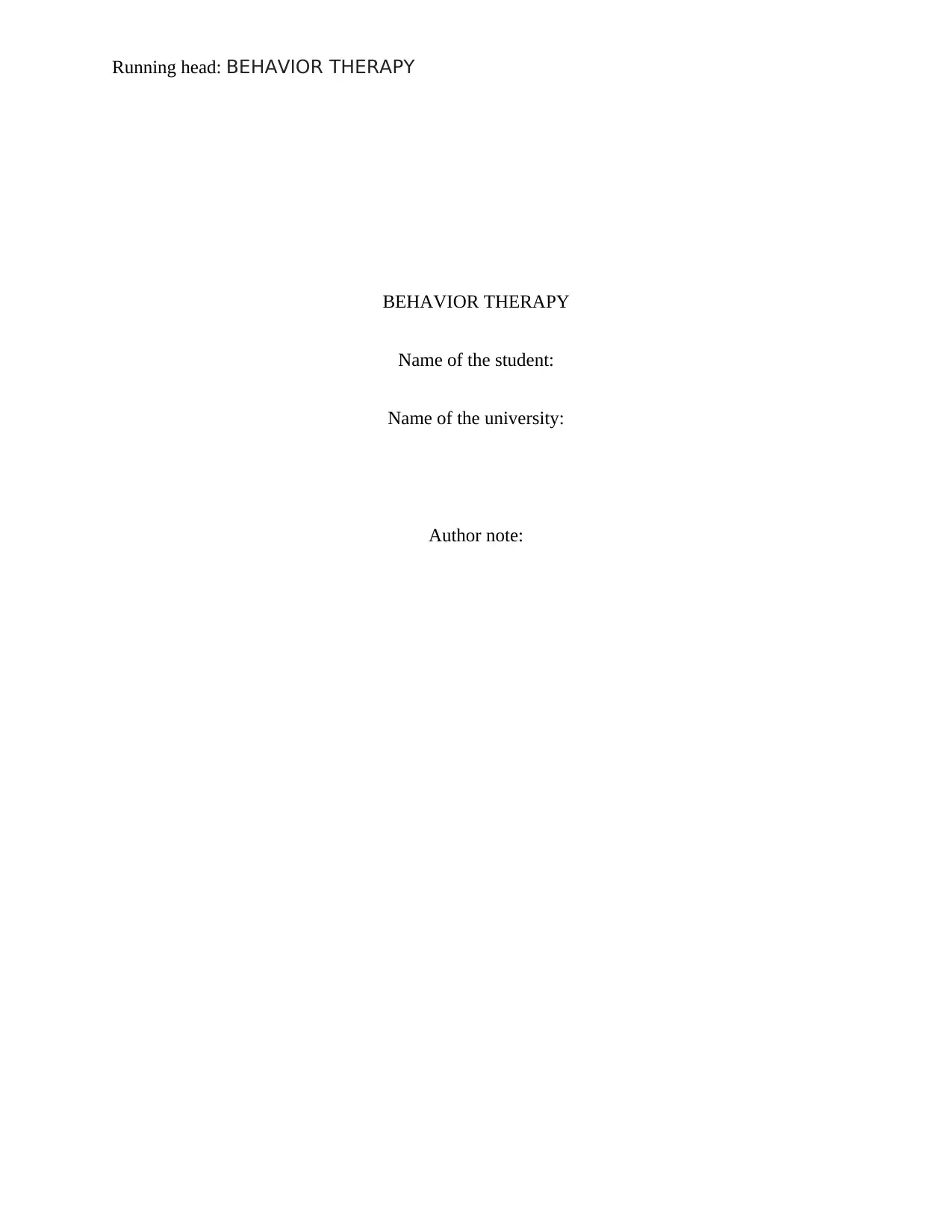
Running head: BEHAVIOR THERAPY
BEHAVIOR THERAPY
Name of the student:
Name of the university:
Author note:
BEHAVIOR THERAPY
Name of the student:
Name of the university:
Author note:
Paraphrase This Document
Need a fresh take? Get an instant paraphrase of this document with our AI Paraphraser
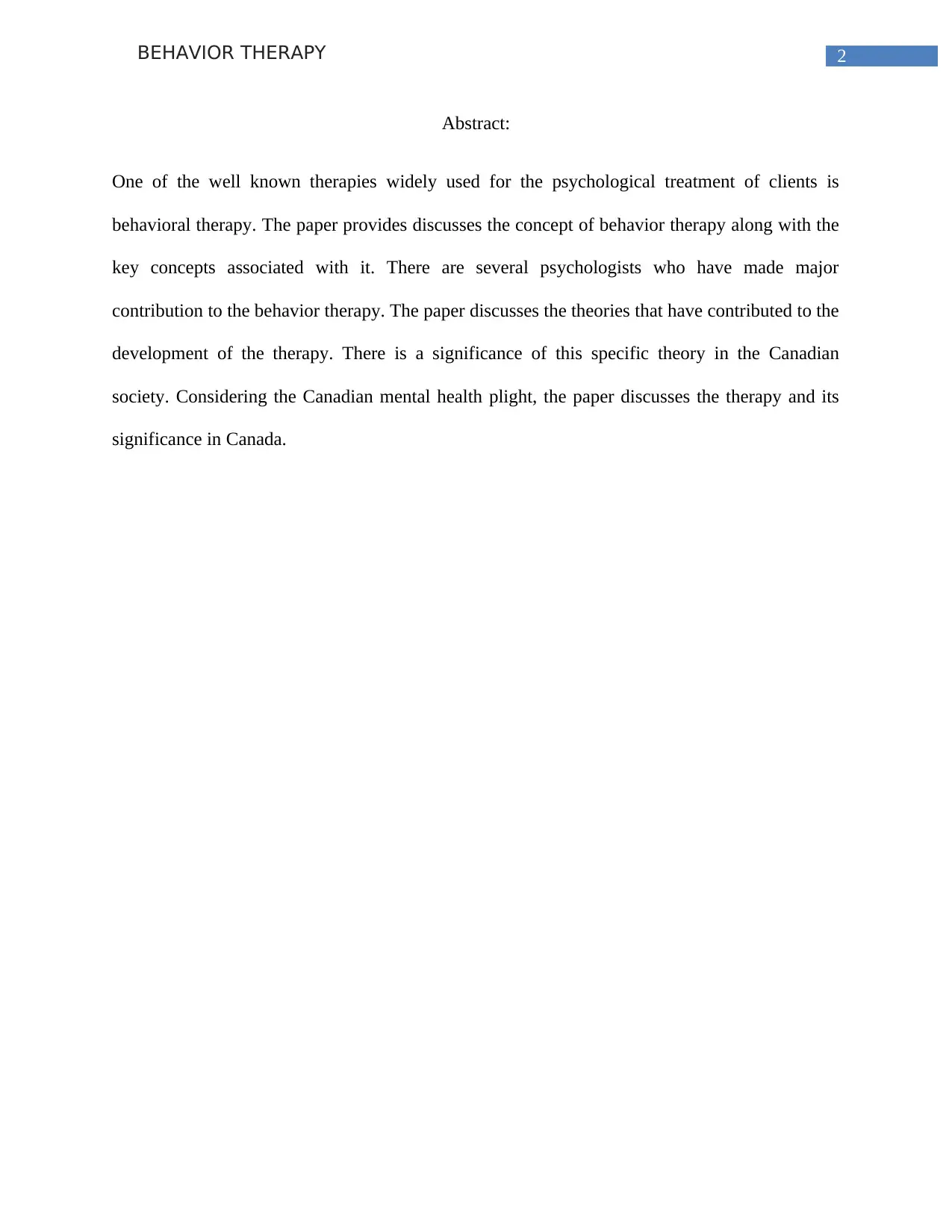
2BEHAVIOR THERAPY
Abstract:
One of the well known therapies widely used for the psychological treatment of clients is
behavioral therapy. The paper provides discusses the concept of behavior therapy along with the
key concepts associated with it. There are several psychologists who have made major
contribution to the behavior therapy. The paper discusses the theories that have contributed to the
development of the therapy. There is a significance of this specific theory in the Canadian
society. Considering the Canadian mental health plight, the paper discusses the therapy and its
significance in Canada.
Abstract:
One of the well known therapies widely used for the psychological treatment of clients is
behavioral therapy. The paper provides discusses the concept of behavior therapy along with the
key concepts associated with it. There are several psychologists who have made major
contribution to the behavior therapy. The paper discusses the theories that have contributed to the
development of the therapy. There is a significance of this specific theory in the Canadian
society. Considering the Canadian mental health plight, the paper discusses the therapy and its
significance in Canada.
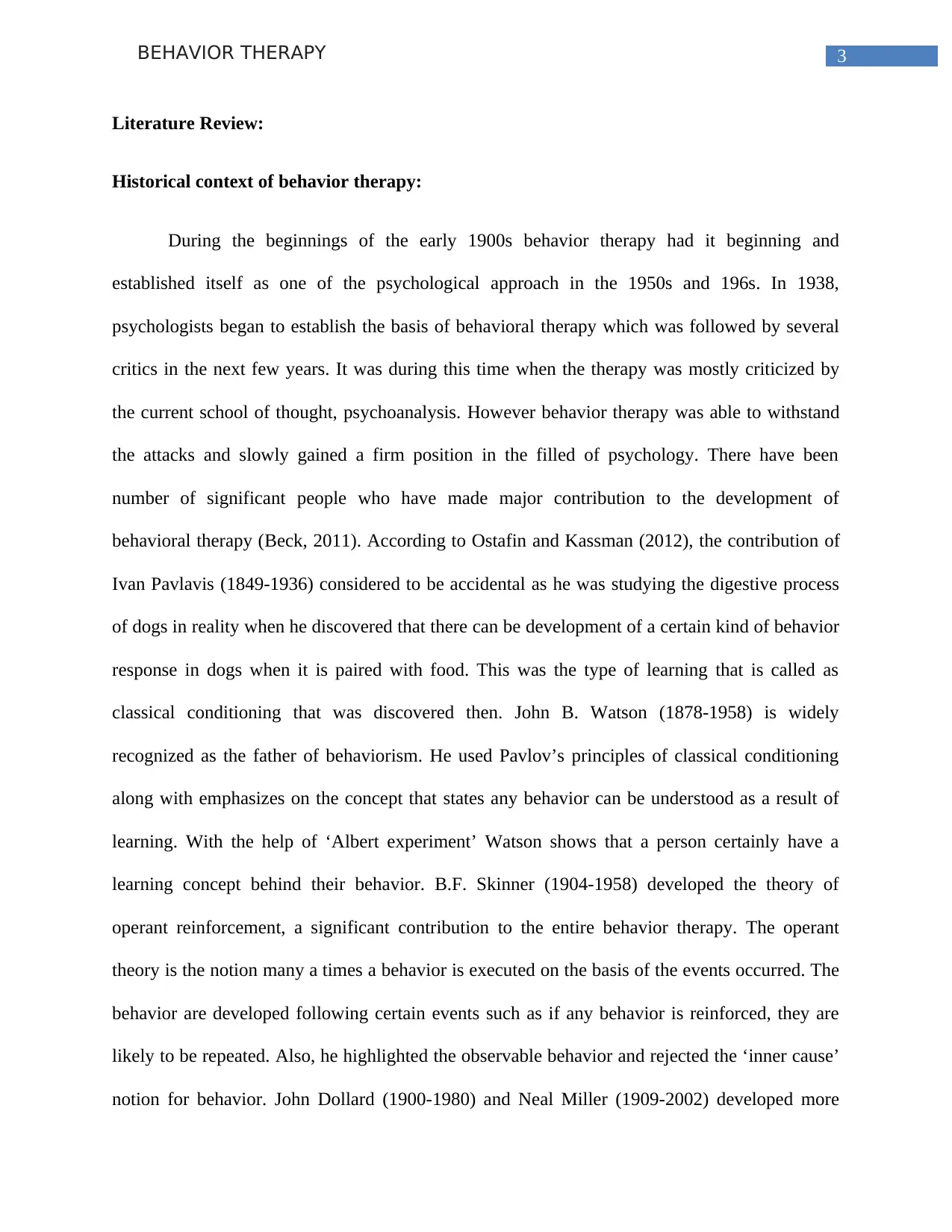
3BEHAVIOR THERAPY
Literature Review:
Historical context of behavior therapy:
During the beginnings of the early 1900s behavior therapy had it beginning and
established itself as one of the psychological approach in the 1950s and 196s. In 1938,
psychologists began to establish the basis of behavioral therapy which was followed by several
critics in the next few years. It was during this time when the therapy was mostly criticized by
the current school of thought, psychoanalysis. However behavior therapy was able to withstand
the attacks and slowly gained a firm position in the filled of psychology. There have been
number of significant people who have made major contribution to the development of
behavioral therapy (Beck, 2011). According to Ostafin and Kassman (2012), the contribution of
Ivan Pavlavis (1849-1936) considered to be accidental as he was studying the digestive process
of dogs in reality when he discovered that there can be development of a certain kind of behavior
response in dogs when it is paired with food. This was the type of learning that is called as
classical conditioning that was discovered then. John B. Watson (1878-1958) is widely
recognized as the father of behaviorism. He used Pavlov’s principles of classical conditioning
along with emphasizes on the concept that states any behavior can be understood as a result of
learning. With the help of ‘Albert experiment’ Watson shows that a person certainly have a
learning concept behind their behavior. B.F. Skinner (1904-1958) developed the theory of
operant reinforcement, a significant contribution to the entire behavior therapy. The operant
theory is the notion many a times a behavior is executed on the basis of the events occurred. The
behavior are developed following certain events such as if any behavior is reinforced, they are
likely to be repeated. Also, he highlighted the observable behavior and rejected the ‘inner cause’
notion for behavior. John Dollard (1900-1980) and Neal Miller (1909-2002) developed more
Literature Review:
Historical context of behavior therapy:
During the beginnings of the early 1900s behavior therapy had it beginning and
established itself as one of the psychological approach in the 1950s and 196s. In 1938,
psychologists began to establish the basis of behavioral therapy which was followed by several
critics in the next few years. It was during this time when the therapy was mostly criticized by
the current school of thought, psychoanalysis. However behavior therapy was able to withstand
the attacks and slowly gained a firm position in the filled of psychology. There have been
number of significant people who have made major contribution to the development of
behavioral therapy (Beck, 2011). According to Ostafin and Kassman (2012), the contribution of
Ivan Pavlavis (1849-1936) considered to be accidental as he was studying the digestive process
of dogs in reality when he discovered that there can be development of a certain kind of behavior
response in dogs when it is paired with food. This was the type of learning that is called as
classical conditioning that was discovered then. John B. Watson (1878-1958) is widely
recognized as the father of behaviorism. He used Pavlov’s principles of classical conditioning
along with emphasizes on the concept that states any behavior can be understood as a result of
learning. With the help of ‘Albert experiment’ Watson shows that a person certainly have a
learning concept behind their behavior. B.F. Skinner (1904-1958) developed the theory of
operant reinforcement, a significant contribution to the entire behavior therapy. The operant
theory is the notion many a times a behavior is executed on the basis of the events occurred. The
behavior are developed following certain events such as if any behavior is reinforced, they are
likely to be repeated. Also, he highlighted the observable behavior and rejected the ‘inner cause’
notion for behavior. John Dollard (1900-1980) and Neal Miller (1909-2002) developed more
⊘ This is a preview!⊘
Do you want full access?
Subscribe today to unlock all pages.

Trusted by 1+ million students worldwide
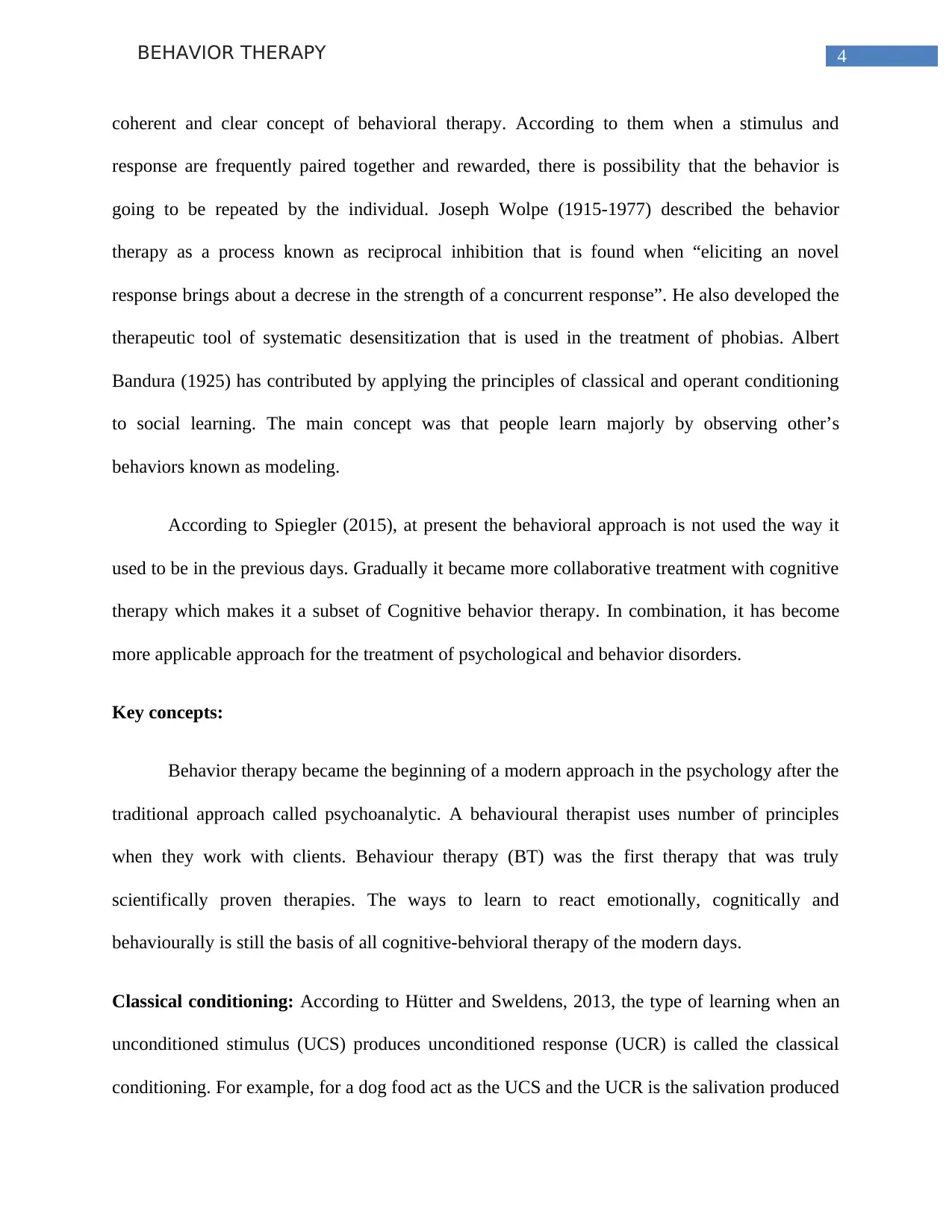
4BEHAVIOR THERAPY
coherent and clear concept of behavioral therapy. According to them when a stimulus and
response are frequently paired together and rewarded, there is possibility that the behavior is
going to be repeated by the individual. Joseph Wolpe (1915-1977) described the behavior
therapy as a process known as reciprocal inhibition that is found when “eliciting an novel
response brings about a decrese in the strength of a concurrent response”. He also developed the
therapeutic tool of systematic desensitization that is used in the treatment of phobias. Albert
Bandura (1925) has contributed by applying the principles of classical and operant conditioning
to social learning. The main concept was that people learn majorly by observing other’s
behaviors known as modeling.
According to Spiegler (2015), at present the behavioral approach is not used the way it
used to be in the previous days. Gradually it became more collaborative treatment with cognitive
therapy which makes it a subset of Cognitive behavior therapy. In combination, it has become
more applicable approach for the treatment of psychological and behavior disorders.
Key concepts:
Behavior therapy became the beginning of a modern approach in the psychology after the
traditional approach called psychoanalytic. A behavioural therapist uses number of principles
when they work with clients. Behaviour therapy (BT) was the first therapy that was truly
scientifically proven therapies. The ways to learn to react emotionally, cognitically and
behaviourally is still the basis of all cognitive-behvioral therapy of the modern days.
Classical conditioning: According to Hütter and Sweldens, 2013, the type of learning when an
unconditioned stimulus (UCS) produces unconditioned response (UCR) is called the classical
conditioning. For example, for a dog food act as the UCS and the UCR is the salivation produced
coherent and clear concept of behavioral therapy. According to them when a stimulus and
response are frequently paired together and rewarded, there is possibility that the behavior is
going to be repeated by the individual. Joseph Wolpe (1915-1977) described the behavior
therapy as a process known as reciprocal inhibition that is found when “eliciting an novel
response brings about a decrese in the strength of a concurrent response”. He also developed the
therapeutic tool of systematic desensitization that is used in the treatment of phobias. Albert
Bandura (1925) has contributed by applying the principles of classical and operant conditioning
to social learning. The main concept was that people learn majorly by observing other’s
behaviors known as modeling.
According to Spiegler (2015), at present the behavioral approach is not used the way it
used to be in the previous days. Gradually it became more collaborative treatment with cognitive
therapy which makes it a subset of Cognitive behavior therapy. In combination, it has become
more applicable approach for the treatment of psychological and behavior disorders.
Key concepts:
Behavior therapy became the beginning of a modern approach in the psychology after the
traditional approach called psychoanalytic. A behavioural therapist uses number of principles
when they work with clients. Behaviour therapy (BT) was the first therapy that was truly
scientifically proven therapies. The ways to learn to react emotionally, cognitically and
behaviourally is still the basis of all cognitive-behvioral therapy of the modern days.
Classical conditioning: According to Hütter and Sweldens, 2013, the type of learning when an
unconditioned stimulus (UCS) produces unconditioned response (UCR) is called the classical
conditioning. For example, for a dog food act as the UCS and the UCR is the salivation produced
Paraphrase This Document
Need a fresh take? Get an instant paraphrase of this document with our AI Paraphraser
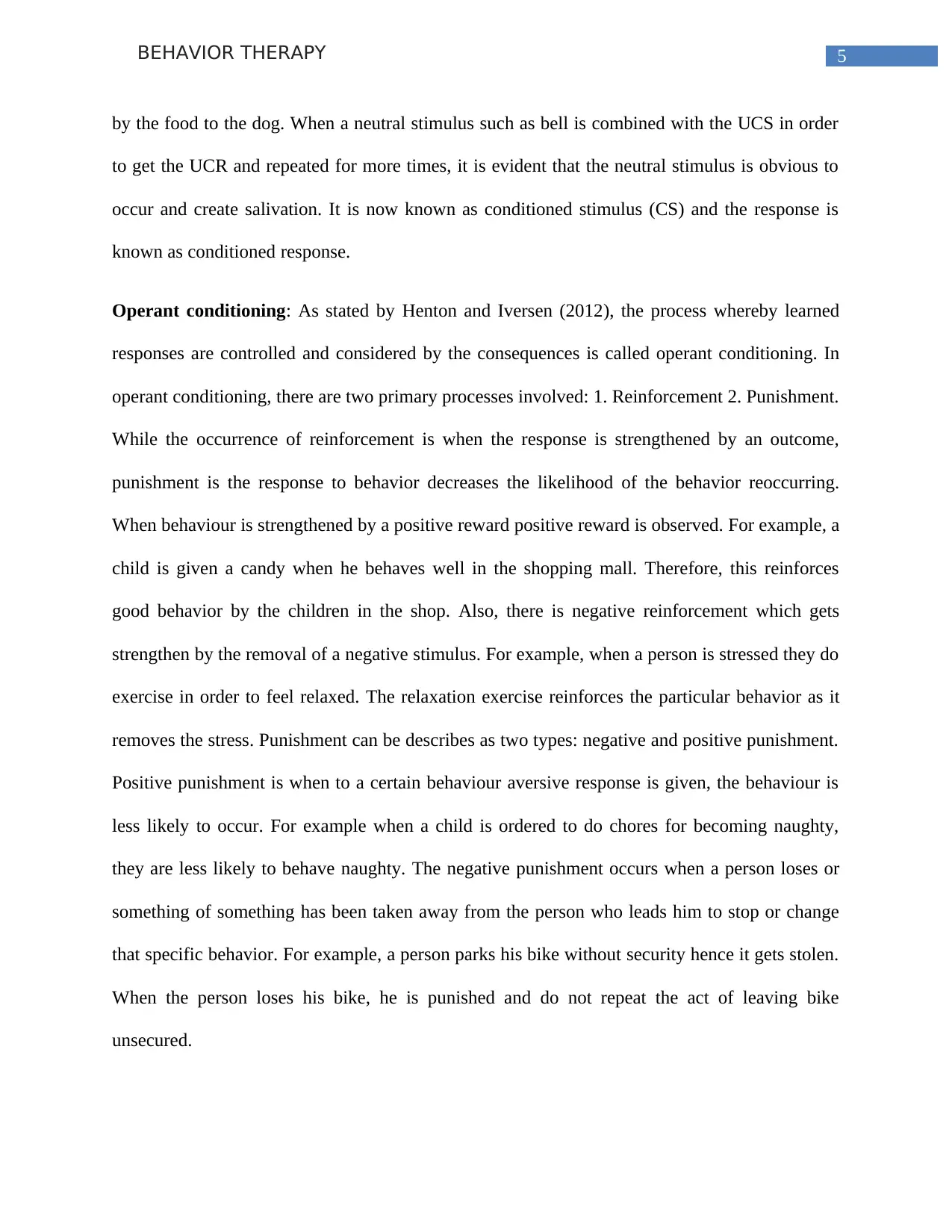
5BEHAVIOR THERAPY
by the food to the dog. When a neutral stimulus such as bell is combined with the UCS in order
to get the UCR and repeated for more times, it is evident that the neutral stimulus is obvious to
occur and create salivation. It is now known as conditioned stimulus (CS) and the response is
known as conditioned response.
Operant conditioning: As stated by Henton and Iversen (2012), the process whereby learned
responses are controlled and considered by the consequences is called operant conditioning. In
operant conditioning, there are two primary processes involved: 1. Reinforcement 2. Punishment.
While the occurrence of reinforcement is when the response is strengthened by an outcome,
punishment is the response to behavior decreases the likelihood of the behavior reoccurring.
When behaviour is strengthened by a positive reward positive reward is observed. For example, a
child is given a candy when he behaves well in the shopping mall. Therefore, this reinforces
good behavior by the children in the shop. Also, there is negative reinforcement which gets
strengthen by the removal of a negative stimulus. For example, when a person is stressed they do
exercise in order to feel relaxed. The relaxation exercise reinforces the particular behavior as it
removes the stress. Punishment can be describes as two types: negative and positive punishment.
Positive punishment is when to a certain behaviour aversive response is given, the behaviour is
less likely to occur. For example when a child is ordered to do chores for becoming naughty,
they are less likely to behave naughty. The negative punishment occurs when a person loses or
something of something has been taken away from the person who leads him to stop or change
that specific behavior. For example, a person parks his bike without security hence it gets stolen.
When the person loses his bike, he is punished and do not repeat the act of leaving bike
unsecured.
by the food to the dog. When a neutral stimulus such as bell is combined with the UCS in order
to get the UCR and repeated for more times, it is evident that the neutral stimulus is obvious to
occur and create salivation. It is now known as conditioned stimulus (CS) and the response is
known as conditioned response.
Operant conditioning: As stated by Henton and Iversen (2012), the process whereby learned
responses are controlled and considered by the consequences is called operant conditioning. In
operant conditioning, there are two primary processes involved: 1. Reinforcement 2. Punishment.
While the occurrence of reinforcement is when the response is strengthened by an outcome,
punishment is the response to behavior decreases the likelihood of the behavior reoccurring.
When behaviour is strengthened by a positive reward positive reward is observed. For example, a
child is given a candy when he behaves well in the shopping mall. Therefore, this reinforces
good behavior by the children in the shop. Also, there is negative reinforcement which gets
strengthen by the removal of a negative stimulus. For example, when a person is stressed they do
exercise in order to feel relaxed. The relaxation exercise reinforces the particular behavior as it
removes the stress. Punishment can be describes as two types: negative and positive punishment.
Positive punishment is when to a certain behaviour aversive response is given, the behaviour is
less likely to occur. For example when a child is ordered to do chores for becoming naughty,
they are less likely to behave naughty. The negative punishment occurs when a person loses or
something of something has been taken away from the person who leads him to stop or change
that specific behavior. For example, a person parks his bike without security hence it gets stolen.
When the person loses his bike, he is punished and do not repeat the act of leaving bike
unsecured.
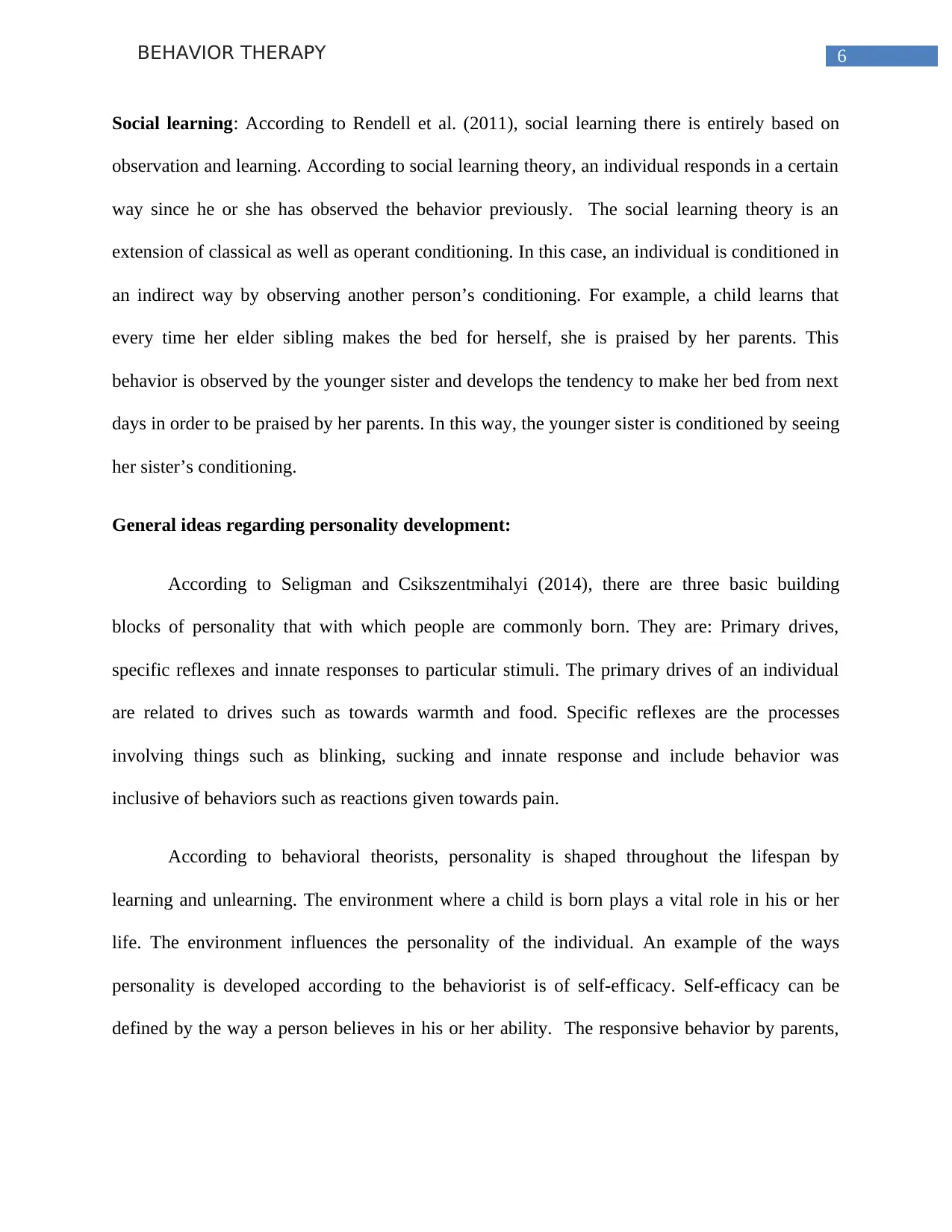
6BEHAVIOR THERAPY
Social learning: According to Rendell et al. (2011), social learning there is entirely based on
observation and learning. According to social learning theory, an individual responds in a certain
way since he or she has observed the behavior previously. The social learning theory is an
extension of classical as well as operant conditioning. In this case, an individual is conditioned in
an indirect way by observing another person’s conditioning. For example, a child learns that
every time her elder sibling makes the bed for herself, she is praised by her parents. This
behavior is observed by the younger sister and develops the tendency to make her bed from next
days in order to be praised by her parents. In this way, the younger sister is conditioned by seeing
her sister’s conditioning.
General ideas regarding personality development:
According to Seligman and Csikszentmihalyi (2014), there are three basic building
blocks of personality that with which people are commonly born. They are: Primary drives,
specific reflexes and innate responses to particular stimuli. The primary drives of an individual
are related to drives such as towards warmth and food. Specific reflexes are the processes
involving things such as blinking, sucking and innate response and include behavior was
inclusive of behaviors such as reactions given towards pain.
According to behavioral theorists, personality is shaped throughout the lifespan by
learning and unlearning. The environment where a child is born plays a vital role in his or her
life. The environment influences the personality of the individual. An example of the ways
personality is developed according to the behaviorist is of self-efficacy. Self-efficacy can be
defined by the way a person believes in his or her ability. The responsive behavior by parents,
Social learning: According to Rendell et al. (2011), social learning there is entirely based on
observation and learning. According to social learning theory, an individual responds in a certain
way since he or she has observed the behavior previously. The social learning theory is an
extension of classical as well as operant conditioning. In this case, an individual is conditioned in
an indirect way by observing another person’s conditioning. For example, a child learns that
every time her elder sibling makes the bed for herself, she is praised by her parents. This
behavior is observed by the younger sister and develops the tendency to make her bed from next
days in order to be praised by her parents. In this way, the younger sister is conditioned by seeing
her sister’s conditioning.
General ideas regarding personality development:
According to Seligman and Csikszentmihalyi (2014), there are three basic building
blocks of personality that with which people are commonly born. They are: Primary drives,
specific reflexes and innate responses to particular stimuli. The primary drives of an individual
are related to drives such as towards warmth and food. Specific reflexes are the processes
involving things such as blinking, sucking and innate response and include behavior was
inclusive of behaviors such as reactions given towards pain.
According to behavioral theorists, personality is shaped throughout the lifespan by
learning and unlearning. The environment where a child is born plays a vital role in his or her
life. The environment influences the personality of the individual. An example of the ways
personality is developed according to the behaviorist is of self-efficacy. Self-efficacy can be
defined by the way a person believes in his or her ability. The responsive behavior by parents,
⊘ This is a preview!⊘
Do you want full access?
Subscribe today to unlock all pages.

Trusted by 1+ million students worldwide
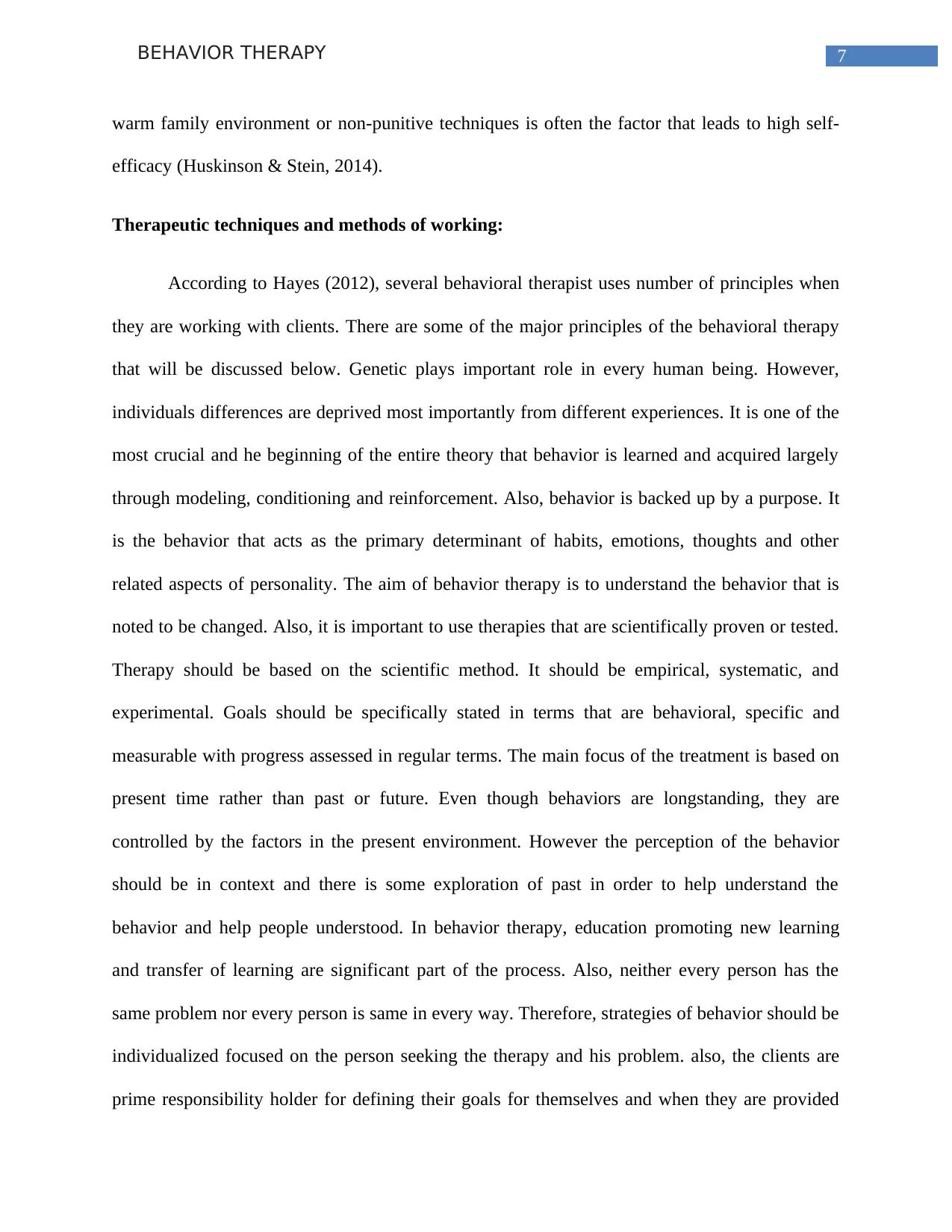
7BEHAVIOR THERAPY
warm family environment or non-punitive techniques is often the factor that leads to high self-
efficacy (Huskinson & Stein, 2014).
Therapeutic techniques and methods of working:
According to Hayes (2012), several behavioral therapist uses number of principles when
they are working with clients. There are some of the major principles of the behavioral therapy
that will be discussed below. Genetic plays important role in every human being. However,
individuals differences are deprived most importantly from different experiences. It is one of the
most crucial and he beginning of the entire theory that behavior is learned and acquired largely
through modeling, conditioning and reinforcement. Also, behavior is backed up by a purpose. It
is the behavior that acts as the primary determinant of habits, emotions, thoughts and other
related aspects of personality. The aim of behavior therapy is to understand the behavior that is
noted to be changed. Also, it is important to use therapies that are scientifically proven or tested.
Therapy should be based on the scientific method. It should be empirical, systematic, and
experimental. Goals should be specifically stated in terms that are behavioral, specific and
measurable with progress assessed in regular terms. The main focus of the treatment is based on
present time rather than past or future. Even though behaviors are longstanding, they are
controlled by the factors in the present environment. However the perception of the behavior
should be in context and there is some exploration of past in order to help understand the
behavior and help people understood. In behavior therapy, education promoting new learning
and transfer of learning are significant part of the process. Also, neither every person has the
same problem nor every person is same in every way. Therefore, strategies of behavior should be
individualized focused on the person seeking the therapy and his problem. also, the clients are
prime responsibility holder for defining their goals for themselves and when they are provided
warm family environment or non-punitive techniques is often the factor that leads to high self-
efficacy (Huskinson & Stein, 2014).
Therapeutic techniques and methods of working:
According to Hayes (2012), several behavioral therapist uses number of principles when
they are working with clients. There are some of the major principles of the behavioral therapy
that will be discussed below. Genetic plays important role in every human being. However,
individuals differences are deprived most importantly from different experiences. It is one of the
most crucial and he beginning of the entire theory that behavior is learned and acquired largely
through modeling, conditioning and reinforcement. Also, behavior is backed up by a purpose. It
is the behavior that acts as the primary determinant of habits, emotions, thoughts and other
related aspects of personality. The aim of behavior therapy is to understand the behavior that is
noted to be changed. Also, it is important to use therapies that are scientifically proven or tested.
Therapy should be based on the scientific method. It should be empirical, systematic, and
experimental. Goals should be specifically stated in terms that are behavioral, specific and
measurable with progress assessed in regular terms. The main focus of the treatment is based on
present time rather than past or future. Even though behaviors are longstanding, they are
controlled by the factors in the present environment. However the perception of the behavior
should be in context and there is some exploration of past in order to help understand the
behavior and help people understood. In behavior therapy, education promoting new learning
and transfer of learning are significant part of the process. Also, neither every person has the
same problem nor every person is same in every way. Therefore, strategies of behavior should be
individualized focused on the person seeking the therapy and his problem. also, the clients are
prime responsibility holder for defining their goals for themselves and when they are provided
Paraphrase This Document
Need a fresh take? Get an instant paraphrase of this document with our AI Paraphraser
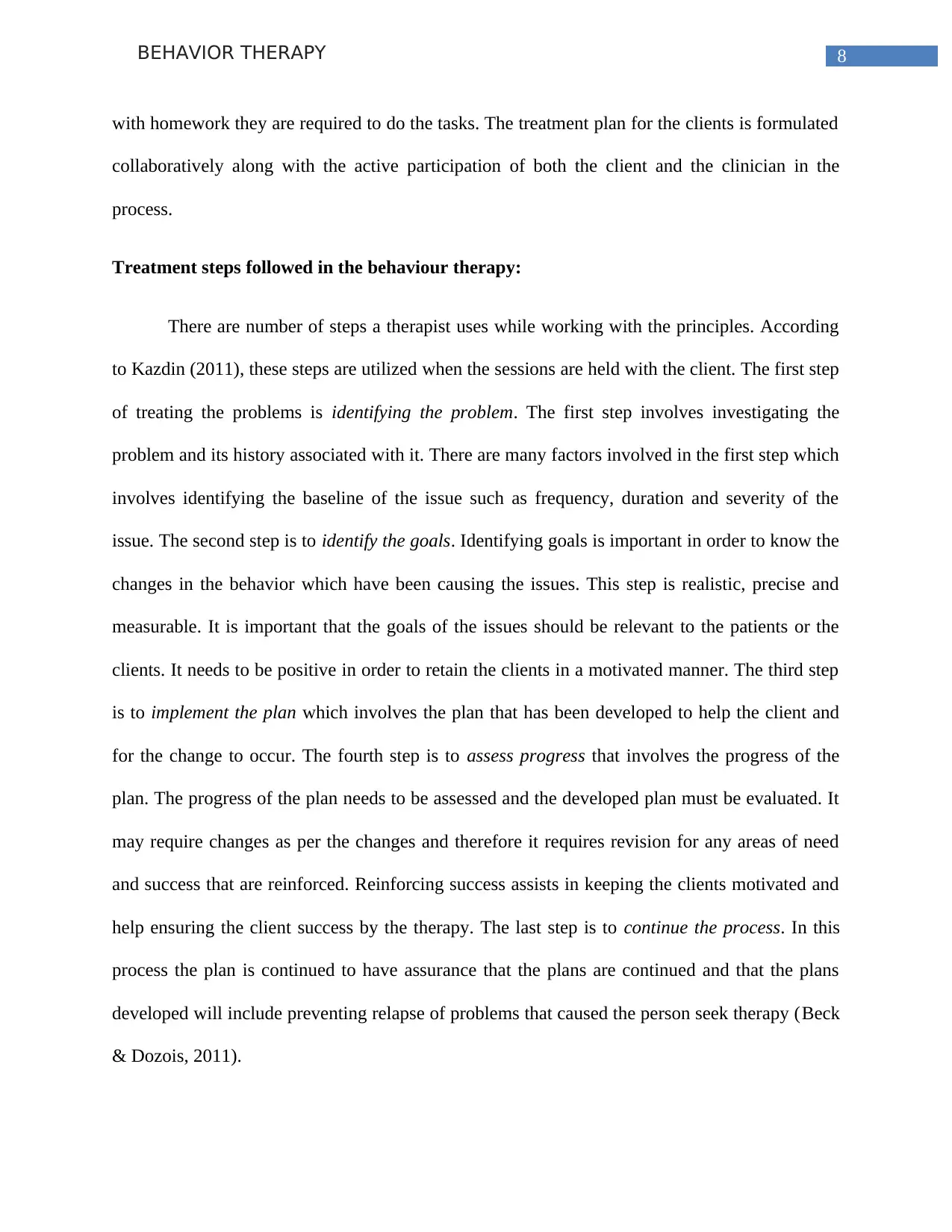
8BEHAVIOR THERAPY
with homework they are required to do the tasks. The treatment plan for the clients is formulated
collaboratively along with the active participation of both the client and the clinician in the
process.
Treatment steps followed in the behaviour therapy:
There are number of steps a therapist uses while working with the principles. According
to Kazdin (2011), these steps are utilized when the sessions are held with the client. The first step
of treating the problems is identifying the problem. The first step involves investigating the
problem and its history associated with it. There are many factors involved in the first step which
involves identifying the baseline of the issue such as frequency, duration and severity of the
issue. The second step is to identify the goals. Identifying goals is important in order to know the
changes in the behavior which have been causing the issues. This step is realistic, precise and
measurable. It is important that the goals of the issues should be relevant to the patients or the
clients. It needs to be positive in order to retain the clients in a motivated manner. The third step
is to implement the plan which involves the plan that has been developed to help the client and
for the change to occur. The fourth step is to assess progress that involves the progress of the
plan. The progress of the plan needs to be assessed and the developed plan must be evaluated. It
may require changes as per the changes and therefore it requires revision for any areas of need
and success that are reinforced. Reinforcing success assists in keeping the clients motivated and
help ensuring the client success by the therapy. The last step is to continue the process. In this
process the plan is continued to have assurance that the plans are continued and that the plans
developed will include preventing relapse of problems that caused the person seek therapy (Beck
& Dozois, 2011).
with homework they are required to do the tasks. The treatment plan for the clients is formulated
collaboratively along with the active participation of both the client and the clinician in the
process.
Treatment steps followed in the behaviour therapy:
There are number of steps a therapist uses while working with the principles. According
to Kazdin (2011), these steps are utilized when the sessions are held with the client. The first step
of treating the problems is identifying the problem. The first step involves investigating the
problem and its history associated with it. There are many factors involved in the first step which
involves identifying the baseline of the issue such as frequency, duration and severity of the
issue. The second step is to identify the goals. Identifying goals is important in order to know the
changes in the behavior which have been causing the issues. This step is realistic, precise and
measurable. It is important that the goals of the issues should be relevant to the patients or the
clients. It needs to be positive in order to retain the clients in a motivated manner. The third step
is to implement the plan which involves the plan that has been developed to help the client and
for the change to occur. The fourth step is to assess progress that involves the progress of the
plan. The progress of the plan needs to be assessed and the developed plan must be evaluated. It
may require changes as per the changes and therefore it requires revision for any areas of need
and success that are reinforced. Reinforcing success assists in keeping the clients motivated and
help ensuring the client success by the therapy. The last step is to continue the process. In this
process the plan is continued to have assurance that the plans are continued and that the plans
developed will include preventing relapse of problems that caused the person seek therapy (Beck
& Dozois, 2011).
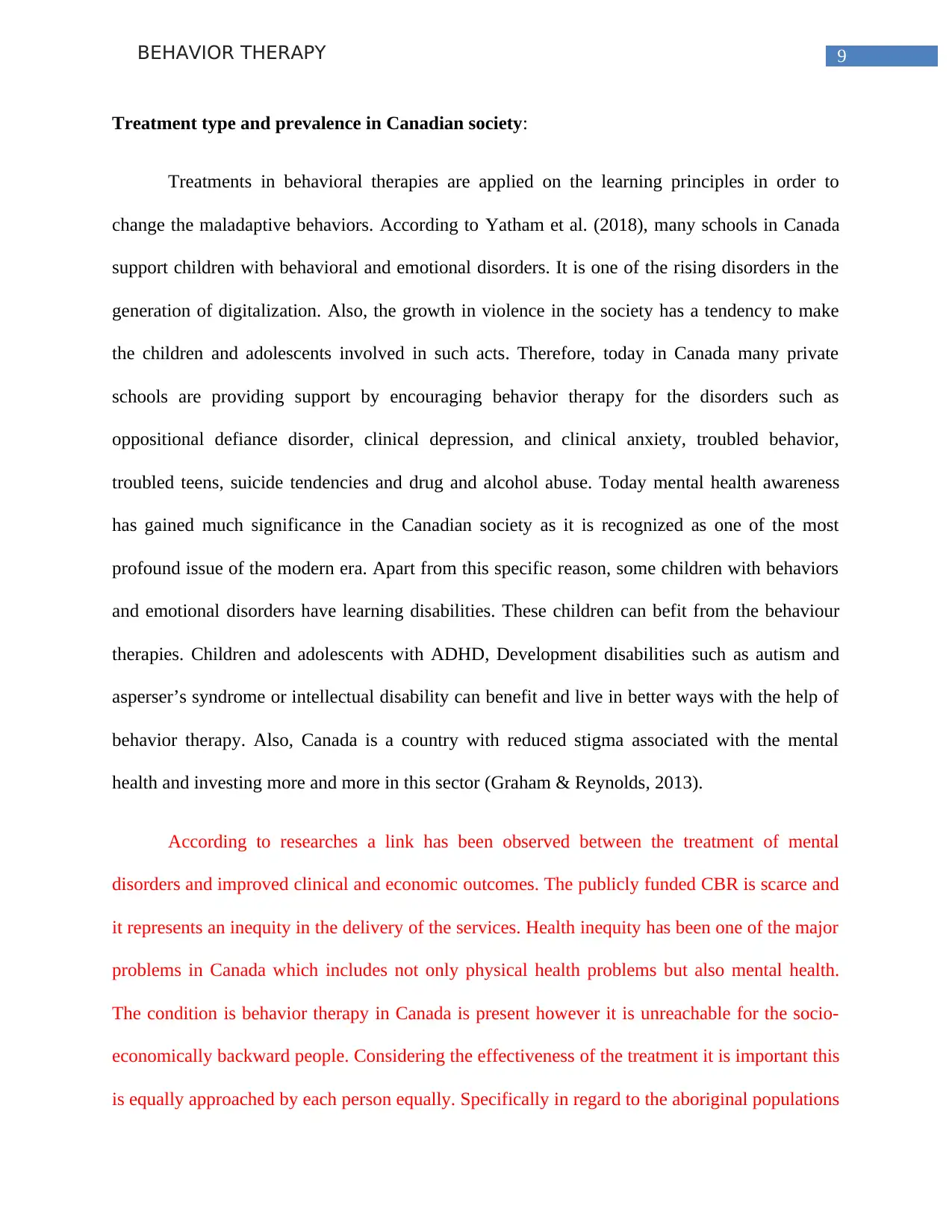
9BEHAVIOR THERAPY
Treatment type and prevalence in Canadian society:
Treatments in behavioral therapies are applied on the learning principles in order to
change the maladaptive behaviors. According to Yatham et al. (2018), many schools in Canada
support children with behavioral and emotional disorders. It is one of the rising disorders in the
generation of digitalization. Also, the growth in violence in the society has a tendency to make
the children and adolescents involved in such acts. Therefore, today in Canada many private
schools are providing support by encouraging behavior therapy for the disorders such as
oppositional defiance disorder, clinical depression, and clinical anxiety, troubled behavior,
troubled teens, suicide tendencies and drug and alcohol abuse. Today mental health awareness
has gained much significance in the Canadian society as it is recognized as one of the most
profound issue of the modern era. Apart from this specific reason, some children with behaviors
and emotional disorders have learning disabilities. These children can befit from the behaviour
therapies. Children and adolescents with ADHD, Development disabilities such as autism and
asperser’s syndrome or intellectual disability can benefit and live in better ways with the help of
behavior therapy. Also, Canada is a country with reduced stigma associated with the mental
health and investing more and more in this sector (Graham & Reynolds, 2013).
According to researches a link has been observed between the treatment of mental
disorders and improved clinical and economic outcomes. The publicly funded CBR is scarce and
it represents an inequity in the delivery of the services. Health inequity has been one of the major
problems in Canada which includes not only physical health problems but also mental health.
The condition is behavior therapy in Canada is present however it is unreachable for the socio-
economically backward people. Considering the effectiveness of the treatment it is important this
is equally approached by each person equally. Specifically in regard to the aboriginal populations
Treatment type and prevalence in Canadian society:
Treatments in behavioral therapies are applied on the learning principles in order to
change the maladaptive behaviors. According to Yatham et al. (2018), many schools in Canada
support children with behavioral and emotional disorders. It is one of the rising disorders in the
generation of digitalization. Also, the growth in violence in the society has a tendency to make
the children and adolescents involved in such acts. Therefore, today in Canada many private
schools are providing support by encouraging behavior therapy for the disorders such as
oppositional defiance disorder, clinical depression, and clinical anxiety, troubled behavior,
troubled teens, suicide tendencies and drug and alcohol abuse. Today mental health awareness
has gained much significance in the Canadian society as it is recognized as one of the most
profound issue of the modern era. Apart from this specific reason, some children with behaviors
and emotional disorders have learning disabilities. These children can befit from the behaviour
therapies. Children and adolescents with ADHD, Development disabilities such as autism and
asperser’s syndrome or intellectual disability can benefit and live in better ways with the help of
behavior therapy. Also, Canada is a country with reduced stigma associated with the mental
health and investing more and more in this sector (Graham & Reynolds, 2013).
According to researches a link has been observed between the treatment of mental
disorders and improved clinical and economic outcomes. The publicly funded CBR is scarce and
it represents an inequity in the delivery of the services. Health inequity has been one of the major
problems in Canada which includes not only physical health problems but also mental health.
The condition is behavior therapy in Canada is present however it is unreachable for the socio-
economically backward people. Considering the effectiveness of the treatment it is important this
is equally approached by each person equally. Specifically in regard to the aboriginal populations
⊘ This is a preview!⊘
Do you want full access?
Subscribe today to unlock all pages.

Trusted by 1+ million students worldwide
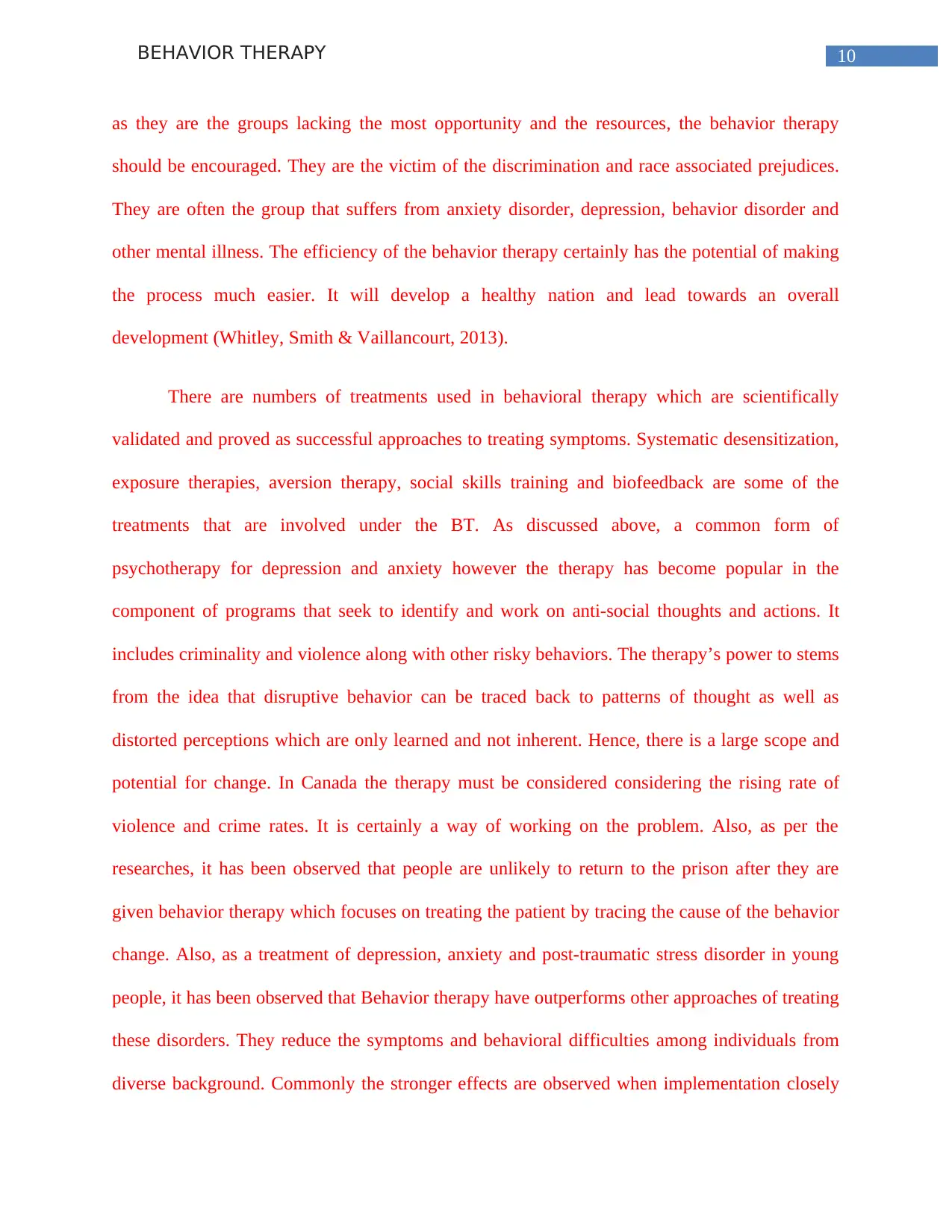
10BEHAVIOR THERAPY
as they are the groups lacking the most opportunity and the resources, the behavior therapy
should be encouraged. They are the victim of the discrimination and race associated prejudices.
They are often the group that suffers from anxiety disorder, depression, behavior disorder and
other mental illness. The efficiency of the behavior therapy certainly has the potential of making
the process much easier. It will develop a healthy nation and lead towards an overall
development (Whitley, Smith & Vaillancourt, 2013).
There are numbers of treatments used in behavioral therapy which are scientifically
validated and proved as successful approaches to treating symptoms. Systematic desensitization,
exposure therapies, aversion therapy, social skills training and biofeedback are some of the
treatments that are involved under the BT. As discussed above, a common form of
psychotherapy for depression and anxiety however the therapy has become popular in the
component of programs that seek to identify and work on anti-social thoughts and actions. It
includes criminality and violence along with other risky behaviors. The therapy’s power to stems
from the idea that disruptive behavior can be traced back to patterns of thought as well as
distorted perceptions which are only learned and not inherent. Hence, there is a large scope and
potential for change. In Canada the therapy must be considered considering the rising rate of
violence and crime rates. It is certainly a way of working on the problem. Also, as per the
researches, it has been observed that people are unlikely to return to the prison after they are
given behavior therapy which focuses on treating the patient by tracing the cause of the behavior
change. Also, as a treatment of depression, anxiety and post-traumatic stress disorder in young
people, it has been observed that Behavior therapy have outperforms other approaches of treating
these disorders. They reduce the symptoms and behavioral difficulties among individuals from
diverse background. Commonly the stronger effects are observed when implementation closely
as they are the groups lacking the most opportunity and the resources, the behavior therapy
should be encouraged. They are the victim of the discrimination and race associated prejudices.
They are often the group that suffers from anxiety disorder, depression, behavior disorder and
other mental illness. The efficiency of the behavior therapy certainly has the potential of making
the process much easier. It will develop a healthy nation and lead towards an overall
development (Whitley, Smith & Vaillancourt, 2013).
There are numbers of treatments used in behavioral therapy which are scientifically
validated and proved as successful approaches to treating symptoms. Systematic desensitization,
exposure therapies, aversion therapy, social skills training and biofeedback are some of the
treatments that are involved under the BT. As discussed above, a common form of
psychotherapy for depression and anxiety however the therapy has become popular in the
component of programs that seek to identify and work on anti-social thoughts and actions. It
includes criminality and violence along with other risky behaviors. The therapy’s power to stems
from the idea that disruptive behavior can be traced back to patterns of thought as well as
distorted perceptions which are only learned and not inherent. Hence, there is a large scope and
potential for change. In Canada the therapy must be considered considering the rising rate of
violence and crime rates. It is certainly a way of working on the problem. Also, as per the
researches, it has been observed that people are unlikely to return to the prison after they are
given behavior therapy which focuses on treating the patient by tracing the cause of the behavior
change. Also, as a treatment of depression, anxiety and post-traumatic stress disorder in young
people, it has been observed that Behavior therapy have outperforms other approaches of treating
these disorders. They reduce the symptoms and behavioral difficulties among individuals from
diverse background. Commonly the stronger effects are observed when implementation closely
Paraphrase This Document
Need a fresh take? Get an instant paraphrase of this document with our AI Paraphraser
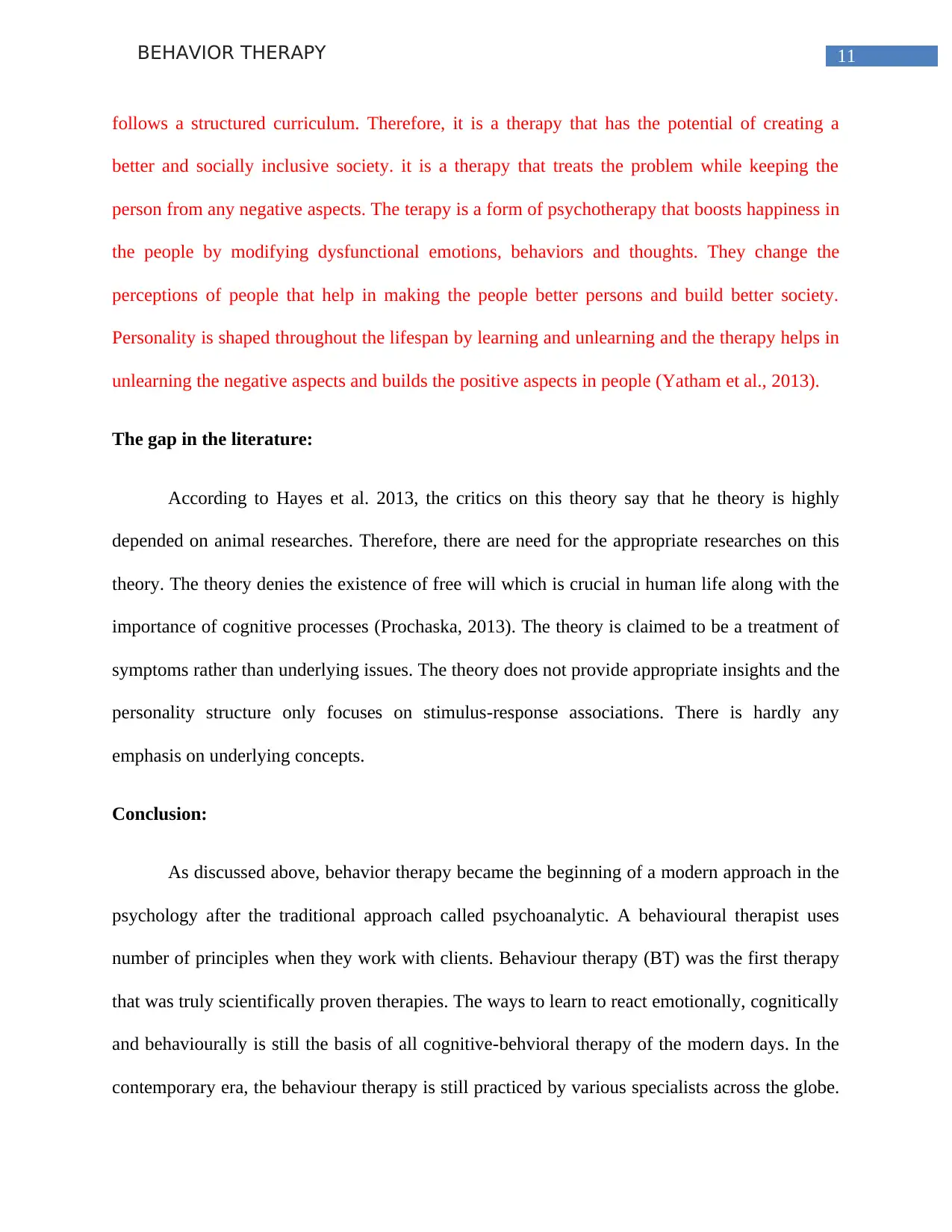
11BEHAVIOR THERAPY
follows a structured curriculum. Therefore, it is a therapy that has the potential of creating a
better and socially inclusive society. it is a therapy that treats the problem while keeping the
person from any negative aspects. The terapy is a form of psychotherapy that boosts happiness in
the people by modifying dysfunctional emotions, behaviors and thoughts. They change the
perceptions of people that help in making the people better persons and build better society.
Personality is shaped throughout the lifespan by learning and unlearning and the therapy helps in
unlearning the negative aspects and builds the positive aspects in people (Yatham et al., 2013).
The gap in the literature:
According to Hayes et al. 2013, the critics on this theory say that he theory is highly
depended on animal researches. Therefore, there are need for the appropriate researches on this
theory. The theory denies the existence of free will which is crucial in human life along with the
importance of cognitive processes (Prochaska, 2013). The theory is claimed to be a treatment of
symptoms rather than underlying issues. The theory does not provide appropriate insights and the
personality structure only focuses on stimulus-response associations. There is hardly any
emphasis on underlying concepts.
Conclusion:
As discussed above, behavior therapy became the beginning of a modern approach in the
psychology after the traditional approach called psychoanalytic. A behavioural therapist uses
number of principles when they work with clients. Behaviour therapy (BT) was the first therapy
that was truly scientifically proven therapies. The ways to learn to react emotionally, cognitically
and behaviourally is still the basis of all cognitive-behvioral therapy of the modern days. In the
contemporary era, the behaviour therapy is still practiced by various specialists across the globe.
follows a structured curriculum. Therefore, it is a therapy that has the potential of creating a
better and socially inclusive society. it is a therapy that treats the problem while keeping the
person from any negative aspects. The terapy is a form of psychotherapy that boosts happiness in
the people by modifying dysfunctional emotions, behaviors and thoughts. They change the
perceptions of people that help in making the people better persons and build better society.
Personality is shaped throughout the lifespan by learning and unlearning and the therapy helps in
unlearning the negative aspects and builds the positive aspects in people (Yatham et al., 2013).
The gap in the literature:
According to Hayes et al. 2013, the critics on this theory say that he theory is highly
depended on animal researches. Therefore, there are need for the appropriate researches on this
theory. The theory denies the existence of free will which is crucial in human life along with the
importance of cognitive processes (Prochaska, 2013). The theory is claimed to be a treatment of
symptoms rather than underlying issues. The theory does not provide appropriate insights and the
personality structure only focuses on stimulus-response associations. There is hardly any
emphasis on underlying concepts.
Conclusion:
As discussed above, behavior therapy became the beginning of a modern approach in the
psychology after the traditional approach called psychoanalytic. A behavioural therapist uses
number of principles when they work with clients. Behaviour therapy (BT) was the first therapy
that was truly scientifically proven therapies. The ways to learn to react emotionally, cognitically
and behaviourally is still the basis of all cognitive-behvioral therapy of the modern days. In the
contemporary era, the behaviour therapy is still practiced by various specialists across the globe.
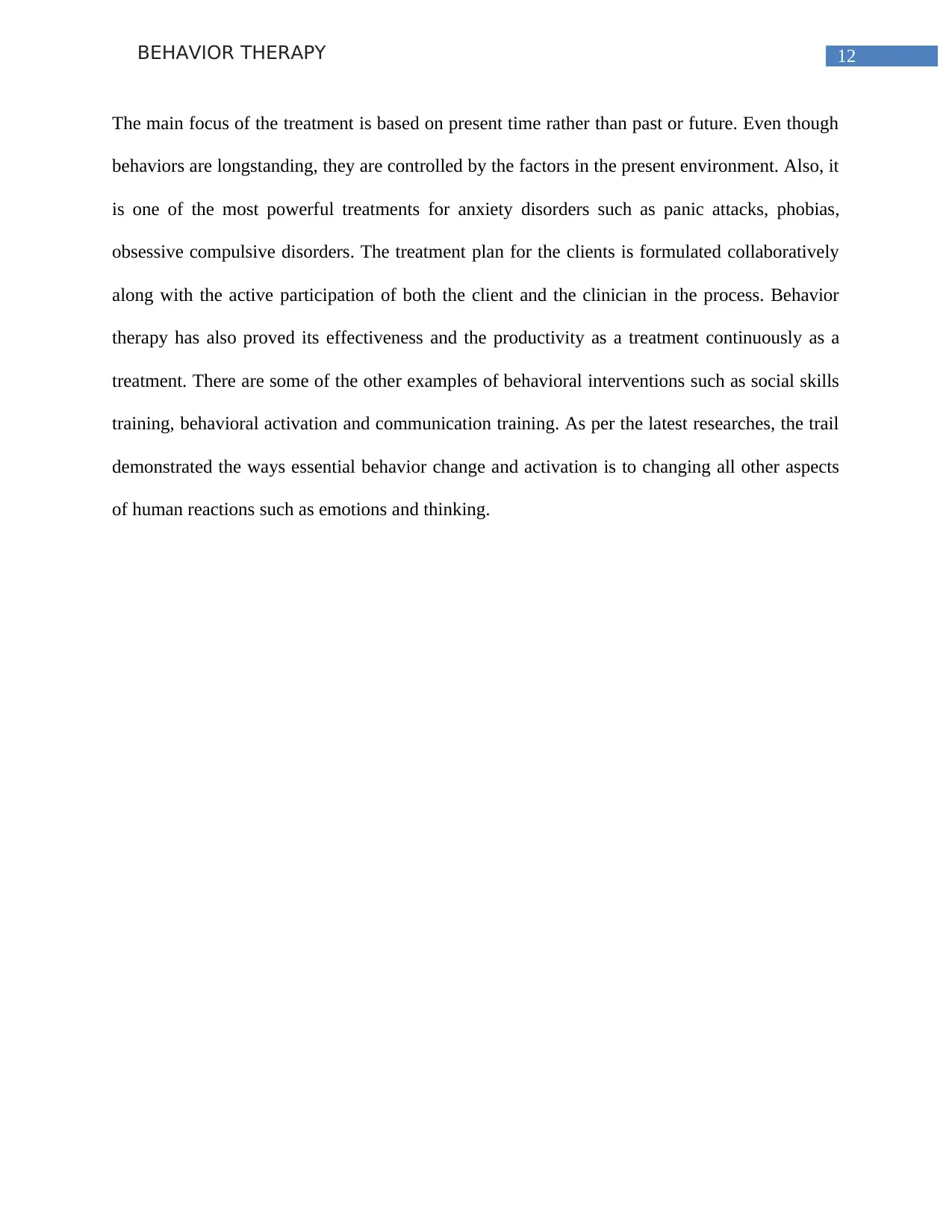
12BEHAVIOR THERAPY
The main focus of the treatment is based on present time rather than past or future. Even though
behaviors are longstanding, they are controlled by the factors in the present environment. Also, it
is one of the most powerful treatments for anxiety disorders such as panic attacks, phobias,
obsessive compulsive disorders. The treatment plan for the clients is formulated collaboratively
along with the active participation of both the client and the clinician in the process. Behavior
therapy has also proved its effectiveness and the productivity as a treatment continuously as a
treatment. There are some of the other examples of behavioral interventions such as social skills
training, behavioral activation and communication training. As per the latest researches, the trail
demonstrated the ways essential behavior change and activation is to changing all other aspects
of human reactions such as emotions and thinking.
The main focus of the treatment is based on present time rather than past or future. Even though
behaviors are longstanding, they are controlled by the factors in the present environment. Also, it
is one of the most powerful treatments for anxiety disorders such as panic attacks, phobias,
obsessive compulsive disorders. The treatment plan for the clients is formulated collaboratively
along with the active participation of both the client and the clinician in the process. Behavior
therapy has also proved its effectiveness and the productivity as a treatment continuously as a
treatment. There are some of the other examples of behavioral interventions such as social skills
training, behavioral activation and communication training. As per the latest researches, the trail
demonstrated the ways essential behavior change and activation is to changing all other aspects
of human reactions such as emotions and thinking.
⊘ This is a preview!⊘
Do you want full access?
Subscribe today to unlock all pages.

Trusted by 1+ million students worldwide
1 out of 15
Related Documents
Your All-in-One AI-Powered Toolkit for Academic Success.
+13062052269
info@desklib.com
Available 24*7 on WhatsApp / Email
![[object Object]](/_next/static/media/star-bottom.7253800d.svg)
Unlock your academic potential
Copyright © 2020–2025 A2Z Services. All Rights Reserved. Developed and managed by ZUCOL.




